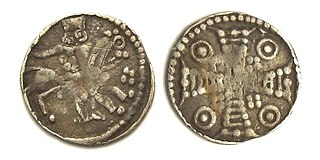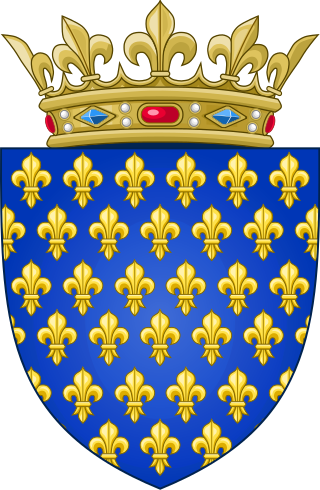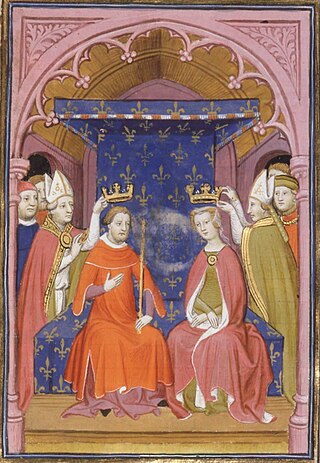
Henry I, named "The Courageous", was a member of the House of Reginar and first duke of Brabant from 1183/84 until his death.

The Duchy of Burgundy emerged in the 9th century as one of the successors of the ancient Kingdom of the Burgundians, which after its conquest in 532 had formed a constituent part of the Frankish Empire. Upon the 9th-century partitions, the French remnants of the Burgundian kingdom were reduced to a ducal rank by King Robert II of France in 1004. Robert II's son and heir, King Henry I of France, inherited the duchy but ceded it to his younger brother Robert in 1032.

Philip of Burgundy was Count of Auvergne and Boulogne in right of his wife. He died during the Siege of Aiguillon.

Philip of Rouvres was the Count of Burgundy and Count of Artois from 1347, Duke of Burgundy from 1349, and Count of Auvergne and Boulogne from 1360. He was the only son of Philip, heir to the Duchy of Burgundy, and Joan I, heiress of Auvergne and Boulogne.

The County of Boulogne was a county within the Kingdom of France during the 9th to 15th centuries, centred on the city of Boulogne-sur-Mer. It was ruled by the counts of Flanders in the 10th century, but a separate House of Boulogne emerged during the 11th century. It was annexed by Philip II of France in 1212, after which it was treated as part of the county of Artois until it was finally annexed into the royal domain in 1550.

Charles de Bourbon was the oldest son of John I, Duke of Bourbon and Marie, Duchess of Auvergne.

Margaret III was a ruling Countess of Flanders, Countess of Artois, and Countess of Auvergne and Boulogne between 1384 and 1405. She was the last Countess of Flanders of the House of Dampierre.

The House of Capet ruled the Kingdom of France from 987 to 1328. It was the most senior line of the Capetian dynasty – itself a derivative dynasty from the Robertians.

Georges de la Trémoille was Count of Guînes from 1398 to 1446 and Grand Chamberlain of France to King Charles VII of France. He sought reconciliation between Philip, Duke of Burgundy and Charles VII during their estrangement in the latter part of the Hundred Years' War. De la Trémoille was a political opponent of Arthur de Richemont within the French court. Most historians take a poor view of his career, assessing that he placed personal advancement before the public interest, though the traditional historical interpretation of the Grand Chamberlain as Jeanne d'Arc's opponent has been revised.

Joan I was ruling Countess of Auvergne and Boulogne from 1332 to 1360 and Queen of France by her marriage to King John II.

Joan II, Countess of Auvergne and Boulogne, also known as Jeanne de Boulogne and Joan, Duchess of Berry, was sovereign Countess of Auvergne and Boulogne from 1394 until 1424. She was the daughter of John II, Count of Auvergne, and second wife of John, Duke of Berry. She is arguably most famous for saving the life of her nephew, King Charles VI of France, during the disastrous Bal des Ardents.
Bonne of Berry was a French countess. She was Countess of Savoy by marriage to Amadeus VII, Count of Savoy. When she was widowed, she unsuccessfully claimed the regency during her son's minority against her mother-in-law in 1391–93. As niece of King Charles V of France, she played a key role in French diplomatic maneuvers intended to consolidate the alliances of the kingdom of France.
Simon of Dammartin was count of Ponthieu. In 1214 he fought against Philip Augustus at the battle of Bouvines. With the Capetian victory at Bouvines, he was exiled. Through negotiations of his wife Marie, he was allowed back in Ponthieu and agreed to not allow his daughters to marry with out royal consent.

Anne of Armagnac, Dame d'Albret, Countess of Dreux was a French noblewoman and a member of the powerful Gascon Armagnac family which played a prominent role in French politics during the Hundred Years War and were the principal adversaries of the Burgundians throughout the Armagnac-Burgundian Civil War. Anne was the wife of Charles II d'Albret.

Margaret of Artois (1285–1311) was the eldest child of Philip of Artois and his wife, Blanche of Brittany. She was a member of the House of Artois. She was married to Louis d'Évreux. By her marriage, Margaret was Countess of Évreux.
Marie I of Auvergne was suo jureCountess of Auvergne and Countess of Boulogne from 1424 to her death in 1437, having inherited the titles from her cousin Joan II, Countess of Auvergne. She was also styled Dame of Montgascon. She was the wife of Bertrand IV de La Tour, and the mother of Bertrand V de La Tour who succeeded her as Count of Auvergne and Boulogne.

Count of Boulogne was a historical title in the Kingdom of France. The city of Boulogne-sur-Mer became the centre of the county of Boulogne during the ninth century. Little is known of the early counts, but the first holder of the title is recorded in the 11th century.
Adelaide of Brabant, born around 1190, died in 1265, was Countess of Boulogne from 1262 to 1265, the third reigning Countess in succession. She was the daughter of Henry I, Duke of Brabant and Matilda of Boulogne.

Robert VII of Auvergne was count of Auvergne and Boulogne from 1317 until his death.















